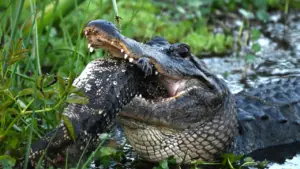Have you ever found yourself pondering the peculiarities of the animal kingdom? Well, today’s curiosity revolves around our scaly friends, the alligators. As we delve into the fascinating world of these ancient reptiles, a rather intriguing question surfaces: Do alligators have tongues?
Yes, indeed, alligators do have tongues. However, their tongues differ from those of mammals in terms of structure and mobility. An alligator’s tongue is relatively immobile and is attached to the bottom of its mouth.
Unlike humans, alligators cannot stick their tongues out, and their tongues play a limited role in vocalization. Instead, they use their tongues primarily to swallow food by retracting it against the roof of their mouth. So, while alligators may not use their tongues for the same purposes as we do, they certainly have this distinctive feature in their anatomy.
Do alligators have tongues?

Yes, alligators do have tongues. However, their tongues are not as flexible or mobile as those of some other animals. Alligator tongues are more or less attached to the floor of the mouth, limiting their range of movement.
The primary functions of an alligator’s tongue are related to feeding and swallowing. When capturing prey, the alligator uses its powerful jaws to catch and hold onto the prey. The tongue assists in positioning the prey within the mouth and guiding it toward the back of the throat for swallowing.
Unlike some animals, alligators do not use their tongues extensively for tasks like grooming, tasting the air, or making complex sounds.
Alligator Tongue Characteristics
The tongue of an alligator has several distinctive characteristics:
- Attachment: The tongue is firmly attached to the floor of the alligator’s mouth. Unlike mammals, such as humans, where the tongue is free-moving and can perform various functions like taste and manipulation, the alligator’s tongue is more restricted in its movement.
- Limited Mobility: The limited mobility of the alligator’s tongue is due to its attachment. Alligators cannot stick their tongues out of their mouths or use them for tasks requiring fine manipulation.
- Function in Feeding: The primary purpose of an alligator’s tongue is related to feeding. It assists in positioning prey within the mouth and helps guide food toward the back of the throat for swallowing.
- Not Adapted for Vocalization: Alligators are not known for making complex vocalizations, and their tongues are not adapted for sophisticated sound production. They do produce sounds, but these are usually low-frequency bellows and grunts rather than a wide range of vocalizations.
- Texture and Appearance: The texture and appearance of an alligator’s tongue can vary. It is generally smooth and muscular, aiding in the manipulation and swallowing of prey.
Unique Features of Alligator Tongues
While the tongue of an alligator shares some common features with other reptiles, there are a few unique aspects worth noting:
- Attachment: One distinctive feature is the way the alligator’s tongue is attached. It is attached along almost the entire length of the mouth’s floor. This attachment limits the mobility of the tongue compared to mammals, where the tongue is more freely movable.
- Function in Feeding: The primary function of the alligator’s tongue is related to feeding. It helps manipulate and position prey within the mouth, facilitating the process of swallowing. The tongue assists in moving prey to the back of the throat, where it can be swallowed whole.
- Lack of Taste Buds: Alligator tongues are not as equipped with taste buds as mammalian tongues. While they can detect certain tastes, they don’t have the same level of taste sensitivity as some other animals. The emphasis is more on the mechanical aspects of capturing and consuming prey.
- Limited Vocalization: Alligators can produce various sounds, including low-frequency bellows and grunts. However, their tongues are not as involved in vocalization as in some other animals. The sounds are mainly produced through the movement of air in the throat and vocal folds.
- Muscular and Adapted for Swallowing: The tongue is muscular and aids in the manipulation and swallowing of prey. It helps create a flow of water within the mouth, assisting in guiding food to the back of the throat.
Function of the alligator’s tongue

Alligators do not use their tongues for chewing or manipulating food like mammals do. The primary functions of an alligator’s tongue are related to hunting, eating, and vocalization.
Here are some key functions:
- Preventing water entry: Alligator tongues have a special adaptation that allows them to fit snugly against the roof of the mouth. This helps in preventing water from entering the throat when the alligator is submerged. Alligators often hunt and capture prey underwater, so this adaptation is crucial for their survival.
- Assisting in eating: Alligator tongues are not as mobile as those of mammals. When an alligator catches prey, it usually swallows it whole. The tongue helps guide food to the back of the throat for swallowing.
- Vocalization: Alligators use various vocalizations to communicate with each other, especially during the mating season. The tongue, along with other structures in the throat, plays a role in producing these vocalizations.
- can produce a range of sounds, including bellows, hisses, and grunts, to establish territory, attract mates, or communicate with other alligators.
It’s important to note that the anatomy and function of the tongue in alligators differ from that of mammals, reflecting their unique adaptations to their aquatic and carnivorous lifestyle.
Comparison of alligator tongues with other reptiles
The tongues of reptiles, including alligators, can vary in structure and function based on their specific adaptations to their environments and lifestyles. Here’s a general comparison of alligator tongues with those of other reptiles:
- Alligators and Crocodiles:
- Structure: Alligators and crocodiles have tongues that are attached to the roof of their mouths by a membrane, making them less mobile than mammalian tongues.
- Function: The primary functions include preventing water entry when submerged, assisting in guiding food to the back of the throat during feeding, and contributing to vocalizations for communication.
- Snakes:
- Structure: Snakes have forked tongues that are highly flexible and can move independently. The forked shape enhances their sense of smell by picking up scent particles from the environment.
- Function: The primary function of a snake’s tongue is chemoreception, helping them detect and locate prey, predators, or potential mates by “tasting” the air.
- Lizards:
- Structure: Lizards have varied tongue structures. Some have simple, fleshy tongues, while others may have forked or specialized tongues.
- Function: The function of a lizard’s tongue depends on its species. In some cases, it assists in locating and capturing prey, while in others, it may be involved in courtship displays or communication.
- Turtles:
- Structure: Turtles have a tongue that is generally less mobile than mammalian tongues and may vary in structure among different species.
- Function: The tongue in turtles is often used to manipulate food within the mouth. Turtles have different feeding strategies, and the tongue contributes to these processes.
Overall, the tongue structure and function in reptiles, including alligators, are diverse and have evolved to suit the specific needs of each species. While alligators use their tongues for functions such as preventing water entry, guiding food, and vocalization, other reptiles like snakes, lizards, and turtles have tongues adapted to their unique lifestyles and ecological roles.
How alligator tongues contribute to their survival
Alligator tongues contribute to the survival of these reptiles in several ways, playing essential roles in their behavior, feeding, and overall adaptation to their environments.
Here are some ways in which alligator tongues contribute to their survival:
- Preventing Water Entry: Alligator tongues have a unique adaptation that allows them to fit tightly against the roof of the mouth. This adaptation is crucial for preventing water from entering the throat when the alligator is submerged. As semi-aquatic creatures, alligators spend a significant amount of time in the water, and this feature helps them hunt and navigate without ingesting water.
- Feeding and Swallowing: While alligators do not chew their food, their tongues help guide prey to the back of the throat for swallowing. The structure of the tongue assists in the manipulation of food within the mouth, facilitating the swallowing of prey items whole. This is particularly important for efficient feeding and energy acquisition.
- Communication: Alligators use a variety of vocalizations for communication, especially during the mating season. The tongue, along with other structures in the throat, contributes to the production of sounds such as bellows, hisses, and grunts. Effective communication is essential for establishing territory, attracting mates, and maintaining social interactions.
- Hunting and Ambushing: Alligators are ambush predators, relying on stealth to capture prey. The ability to keep the mouth tightly closed and use the tongue to create a watertight seal allows alligators to remain hidden underwater while waiting for prey to approach. This ambush strategy is effective for hunting and helps conserve energy.
- Chemoreception: While not as pronounced as in snakes, alligators possess chemoreceptive capabilities. The tongue may play a role in detecting chemical cues in the water, aiding in the location of prey or potential mates.
How alligator hurt their tongue

Alligators can injure their tongues through various activities or encounters that pose a risk to their oral structures. While alligators are robust and resilient creatures, injuries to their tongues can occur due to the following reasons:
- Aggressive Interactions: Alligators are territorial and can be aggressive, especially during the breeding season. Male alligators, in particular, may engage in territorial disputes or fights over mates. These confrontations can lead to bites and injuries, including damage to the tongue.
- Prey Capture: Alligators typically capture prey by ambushing them near the water’s edge or in the water. However, during the process of capturing and subduing prey, there is a potential for injuries, and the tongue might be vulnerable to bites or injuries from struggling prey.
- Accidental Injuries: Alligators might encounter various objects in their environment, including rocks, branches, or other debris. Accidental collisions or interactions with these objects could result in tongue injuries.
- Human Interactions: In areas where humans and alligators coexist, there is a risk of encounters that can lead to injuries for both parties. If an alligator feels threatened or provoked, it may defend itself, and during such encounters, injuries to the tongue can occur.
- Environmental Factors: Harsh environmental conditions or changes in water quality can also contribute to injuries. Exposure to pollutants, toxins, or infectious agents may affect the health of the oral cavity, including the tongue.
You should know that alligators have a remarkable ability to heal from injuries. Their immune systems are adapted to deal with various challenges, and they can recover from wounds over time. In the wild, alligators rely on their resilience, natural behaviors, and adaptive capabilities to cope with injuries and maintain their survival.
If an alligator sustains a severe injury, however, it could impact its ability to hunt, eat, and survive in the wild. In captivity, injured alligators may receive veterinary care to address and monitor their health.
How to keep alligator tongue healthy
Conclusion
On this page you will learn more about alligators tongue and especially get the answers to the question do alligators have tongues. Alligators have tongues that play essential roles in preventing water entry, guiding prey for swallowing, contributing to vocalizations, and supporting their overall survival in diverse environments.

